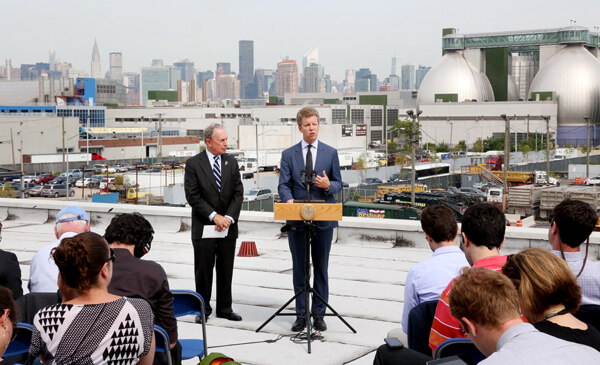By Christina Santucci
Should there be another Superstorm Sandy in Queens’ future, the federal government wants to be prepared to withstand the extreme weather and rebuild in its wake, officials announced Monday.
The Rebuilding Strategy includes 69 policy recommendations for restoring Sandy-ravaged communities and safeguarding against extreme weather, and officials hope it will serve as a model nationwide for communities devastated by a natural disaster. The plan sets guidelines for about $50 billion in federal recovery funds approved in January, of which hundreds of thousands have already been doled out, according to the report.
U.S. Housing and Urban Development Secretary Shaun Donovan, who chairs the president’s Hurricane Sandy Rebuilding Task Force, which was created in December, was joined by Mayor Michael Bloomberg in Brooklyn for the 200-page document’s release.
“This work is helping entire communities move beyond this painful time in their lives. But as they do so, it is important not just to rebuild, but to better prepare the region for the existing and future threats exacerbated by climate change,” Donovan wrote in a letter included in the report.
Some of the most important parts of the strategy are plans to prioritize all large-scale infrastructure projects, determine how they are connected and set guidelines to ensure that construction can withstand the impacts of climate change, officials said.
Flood-protection standards for these major infrastructure projects relying on federal money are one of many parts of the plan already implemented, as well as the creation of an interactive, web-based map and a sea level rise calculator to be considered during the rebuilding process.
In addition, the report made recommendations for preventing extensive power outages in the event of future storms.
“Despite the size and power of Hurricane Sandy, this was not inevitable: resilient energy solutions could have helped limit power outages,” the strategy read.
Recommendations include making sure that energy projects using Sandy recovery funds are resilient, preventing the disruption to fuel chain supply and encouraging states to work with the U.S. Department of Energy to improve electric grid policies and standards were outlined in the plan, along with suggestions for brainstorming with community partners for innovative solutions and developing a plan so cellphones still work regardless of the status of the electrical grid.
The report praised the city’s Rapid Repair Program, which it said helped keep temporary housing open for those most in need.
“This program funded temporary emergency repairs, which permitted homeowners to quickly restore their dwellings to a level of habitability,” the document read.
One section of the strategy also examined how different aspects of infrastructure, including transportation, were affected by the hurricane and what impacts these had on residents in storm-ravaged regions.
Citing a report completed by the Rudin Center for Transportation NYU Wagner Graduate School of Public Service, the plan said that the average commute time for Queens residents before and after Sandy remained the same at about 50 minutes. The borough was the only one of the five boroughs where travel time remained stable, while commuters from Staten Island experienced rides by as much as 2 1/2 hours.



































